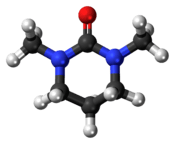DMPU
 | |
 | |
| Names | |
|---|---|
| IUPAC name
1,3-Dimethyltetrahydropyrimidin-2(1H)-one | |
| Other names
N,N'-Dimethyl-N,N'-trimethyleneurea N,N'-Dimethylpropyleneurea 1,3-Dimethyl-3,4,5,6-tetrahydro-2(1H)-pyrimidinone | |
| Identifiers | |
| 7226-23-5 | |
| 3D model (Jmol) | Interactive image |
| Abbreviations | DMPU |
| ChEMBL | ChEMBL12284 |
| ChemSpider | 73671 |
| ECHA InfoCard | 100.027.841 |
| EC Number | 230-625-6 |
| PubChem | 81646 |
| |
| |
| Properties | |
| C6H12N2O | |
| Molar mass | 128.18 g·mol−1 |
| Density | 1.064 g/cm3 |
| Melting point | −20 °C; −4 °F; 253 K |
| Boiling point | 246.5 °C (475.7 °F; 519.6 K) (Source) |
| miscible | |
| Refractive index (nD) |
1.4875-1.4895 |
| Hazards | |
| Safety data sheet | External MSDS |
| R-phrases | R22 R41 R62 |
| S-phrases | S26 S36/37/39 S45 |
| Flash point | 121 °C (250 °F; 394 K) |
| Except where otherwise noted, data are given for materials in their standard state (at 25 °C [77 °F], 100 kPa). | |
| | |
| Infobox references | |
1,3-Dimethyl-3,4,5,6-tetrahydro-2(1H)-pyrimidinone (DMPU) is a cyclic urea sometimes used as a polar, aprotic organic solvent. In 1985, Dieter Seebach showed that it is possible to substitute the relatively toxic hexamethylphosphoramide (HMPA) with DMPU.[1]
References
- ↑ Mukhopadhyay, T.; Seebach, D. (1982). "Substitution of HMPT by the cyclic urea DMPU as a cosolvent for highly reactive nucleophiles and bases". Helvetica Chimica Acta. 65 (1): 385–391. doi:10.1002/hlca.19820650141.
Further reading
- Dehmlow, E. V.; Rao, Y. R. (1988). "Phase transfer catalytic preparation of the dipolar aprotic solvents DMI and DMPU". Synthetic Communications. 18 (5): 487–494. doi:10.1080/00397918808060741.
- Anderson, J. C.; Smith, S. C. (1990). "Oxodiperoxymolybdenum(pyridine)-1,3-dimethyl-3,4,5,6-tetrahydro-2(1H)-pyrimidinone (MoO5 · Py · DMPU): A safer alternative to MoOPH for the α-hydroxylation of carbonyl compounds". Synlett. 1990 (2): 107–108. doi:10.1055/s-1990-21003.
This article is issued from Wikipedia - version of the 7/27/2016. The text is available under the Creative Commons Attribution/Share Alike but additional terms may apply for the media files.